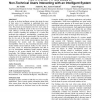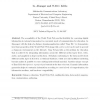194 search results - page 11 / 39 » Learning whom to trust: using graphical models for learning ... |
CHI
2007
ACM
14 years 7 months ago
2007
ACM
In order to develop intelligent systems that attain the trust of their users, it is important to understand how users perceive such systems and develop those perceptions over time...
DAGSTUHL
2007
13 years 8 months ago
2007
arrhythmias (extended abstract) Elisa Fromont, Ren´e Quiniou, Marie-Odile Cordier We are interested in using parallel universes to learn interpretable models that can be subseque...
UAI
2008
13 years 8 months ago
2008
We introduce a new type of graphical model called a `cumulative distribution network' (CDN), which expresses a joint cumulative distribution as a product of local functions. ...
BMCBI
2007
13 years 7 months ago
2007
Background: Features of a DNA sequence can be found by compressing the sequence under a suitable model; good compression implies low information content. Good DNA compression mode...
WEBNET
1997
13 years 8 months ago
1997
–The accessibility of the World Wide Web and its flexibility for conveying digital information in various forms makes it a convenient mode of communication for education. In thi...


